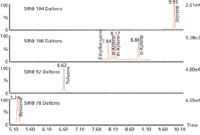The Determination of Low Levels of Benzene, Toluene, Ethylbenzene, Xylenes, and Styrene in Olive Oil Using HS-GC–MS
Levels of benzene, toluene, ethylbenzene, xylenes, and styrene (BTEXS) are a concern in olive oil. These compounds find their way into olive trees and hence into olives and olive oil mainly as a result of emissions from vehicles, bonfires, and paints into ambient air near orchards. This analysis uses a PerkinElmer? TurboMatrix? 110 Headspace (HS) sampler with a Clarus? SQ 8 gas chromatograph–mass spectrometer (GC–MS) to achieve detection limits below 5 ng/g and concentrations up to 100 ng/g.
Levels of benzene, toluene, ethylbenzene, xylenes, and styrene (BTEXS) are a concern in olive oil. These compounds find their way into olive trees and hence into olives and olive oil mainly as a result of emissions from vehicles, bonfires, and paints into ambient air near orchards. This analysis uses a PerkinElmer® TurboMatrix™ 110 Headspace (HS) sampler with a Clarus® SQ 8 gas chromatograph–mass spectrometer (GC–MS) to achieve detection limits below 5 ng/g and concentrations up to 100 ng/g.
For this method, sample preparation is extremely easy. 10 g of olive oil is weighed into a standard headspace vial, then sealed with a crimped cap. The HS sampler heats the vial at 90 °C for 20 min. During this period the BTEXS components transition from the sample matrix into the vapor phase above. A fixed volume of the HS vapor is extracted from the vial and introduced into a Carbowax-type capillary column for GC separation. A quadrupole mass spectrometer is used to detect and quantify the BTEXS components. By using the MS single-ion monitoring (SIM) mode of operation, the detector sensitivity and selectivity is significantly enhanced and clean chromatography is obtained even at low analyte levels. The Clarifi™ SQ 8 MS detector is able to operate in SIFI mode in which both SIM and full scan data are collected. This enables library searches of MS spectral data to assist with confirmation of the identity of specific components while at the same time benefitting from SIM operation.

Figure 1: Chromatogram of 17 ng/g BTEXS in 10 g "cleaned" olive oil.
The analysis is fully automated and takes just 10.5 min for the chromatography plus 3.5 min for cool-down and equilibration between analyses. Sub-ppb levels are possible using standard headspace sampling of light aromatics in a complex natural oil matrix without the need for vapor pre-concentration (for example with an HS Trap).
The figure below shows typical chromatography obtained from a sample of cleaned olive oil fortified with approximately 17 ng/g of the BTEXS components. Note: the only sample that had low levels of BTEX was in the California sample. It is likely that the olive oil was produced by a solvent extraction method.
Excellent quantitative performance was demonstrated from ten samples of cleaned olive oil fortified with approximately 45 ng/g of the BTEXS components. Each was analyzed using the HS-GC-MS system and an overall quantitative precision of 1.69 to 3.76% relative standard deviation was obtained, which is a very good result for this complex matrix.
Seven different brands of olive oil were purchased from a local supermarket and analyzed using this method. The results are given in the table below. Alarmingly high levels of BTEXS components were found in many of the supermarket samples. The only sample that had low levels was one from California. Solvents were found in the California sample so it is likely that the olive oil was produced by a solvent extraction method rather than the more traditional olive-pressing method.
PerkinElmer, Inc.
940 Winter Street, Waltham, MA 02451
tel. (800) 762-4000, fax (203) 944-4904
Website: www.perkinelmer.com

New Study Reviews Chromatography Methods for Flavonoid Analysis
April 21st 2025Flavonoids are widely used metabolites that carry out various functions in different industries, such as food and cosmetics. Detecting, separating, and quantifying them in fruit species can be a complicated process.
Analytical Challenges in Measuring Migration from Food Contact Materials
November 2nd 2015Food contact materials contain low molecular weight additives and processing aids which can migrate into foods leading to trace levels of contamination. Food safety is ensured through regulations, comprising compositional controls and migration limits, which present a significant analytical challenge to the food industry to ensure compliance and demonstrate due diligence. Of the various analytical approaches, LC-MS/MS has proved to be an essential tool in monitoring migration of target compounds into foods, and more sophisticated approaches such as LC-high resolution MS (Orbitrap) are being increasingly used for untargeted analysis to monitor non-intentionally added substances. This podcast will provide an overview to this area, illustrated with various applications showing current approaches being employed.

.png&w=3840&q=75)

.png&w=3840&q=75)



.png&w=3840&q=75)



.png&w=3840&q=75)
















